

Wendy Kaplar
Ingredients For Successful Word Family Instruction - Differentiated Kindergarten. It’s the thirty-second day of school.

Over half my kindersare ‘Top Bananas,’ I’ve introduced and we’ve reviewed over half the letters of the alphabet, they showing signs of segmenting and blending, they totally ‘get’ patterns, and I’m feeling like it’s time to introduce word families. Since you all have had so many questions about this part of my classroom routine, I thought I’d show you a bit more about how I introduce, differentiate and maintain this part of my ELA instruction. I’m going to warn you, this could be a long one so hang in there with me. When To Introduce Word Families Every year isn’t the same. Whole Group Introduction/Instruction I always introduce my word families the same way, one word family each week. Letter Sounds Tic Tac Toe. Picture cards are a must in early literacy learning.
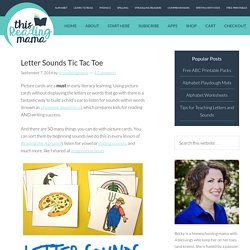
Using picture cards without displaying the letters or words that go with them is a fantastic way to build a child’s ear to listen for sounds within words {known as phonemic awareness}, which prepares kids for reading AND writing success. And there are SO many things you can do with picture cards. You can sort them by beginning sounds {we do this in every lesson of Reading the Alphabet}, listen for vowel or ending sounds, and much more, like I shared at Imagination Soup. These past couple of weeks, MBug {age 4} and I used the Letter Sounds Picture Cards from our Updated & Expanded Reading the Alphabet curriculum and Letter Sounds Tic Tac Toe. It was a highly effective way to get her to listen for, match, and strategize with beginning letter sounds. Prepare Letter Sounds Tic Tac Toe. Fabulous in First: Fun on the Farm! Last week we started one of my favorite units in first grade.
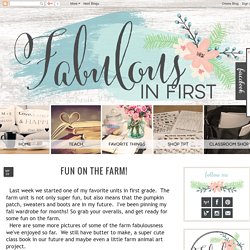
The farm unit is not only super fun, but also means that the pumpkin patch, sweaters and boots are in my future. I've been pinning my fall wardrobe for months! So grab your overalls, and get ready for some fun on the farm. Here are some more pictures of some of the farm fabulousness we've enjoyed so far. We still have butter to make, a super cute class book in our future and maybe even a little farm animal art project.
Below is a little phonics activity we did during morning meeting on Monday. It's about 9 years old, but it serves it's purpose year after year and the kiddos love it. Farm animals were abundant during center time. Here my sweeties are putting the animals in order from least to greatest. One Sharp Bunch: Poetry Activities for the Primary Classroom. Hi, friends!

Can you all believe that today is the first day of spring?! RTI: Phonemic Awareness. I don’t know about you all, but RTI is definitely in full motion!
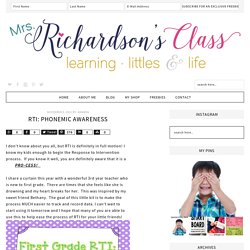
I know my kids enough to begin the Response to Intervention process. If you know it well, you are definitely aware that it is a PRO-CESS! Even MORE! File Folder Phonics - Make Take & Teach. I absolutely love activities that are super easy to set up and can be used over and over again.

Sure, it takes a little bit of cutting and laminating on the front end, but when they are all assembled you’ll have activities that will last for years! Last year I created file folder activities for my second grade teacher friends to address higher level phonics concepts. Free Phonics Books. Inspector Phonics. This was a very quick activity to set up and J really enjoyed it!
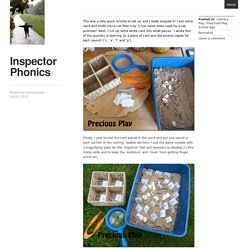
I put some sand and shells into a cat litter tray, it has never been used by a cat, promise!! Next, I cut up some white card into small pieces. First Grade School Box: Phonics. Phonics Interventions for Struggling Readers in K-2 - Learning at the Primary Pond. During the past few weeks, I’ve been writing about how to support beginning readers who struggle with decoding.
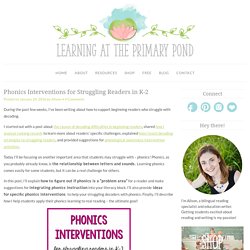
I started out with a post about the causes of decoding difficulties in beginning readers, shared how I analyze running records to learn more about readers’ specific challenges, explained how I teach decoding strategies to struggling readers, and provided suggestions for phonological awareness intervention activities. Today I’ll be focusing on another important area that students may struggle with – phonics! Phonics, as you probably already know, is the relationship between letters and sounds. Teach123 - Tips for Teachers: FREE Fluency Center. Does your school use the Dibel's test?
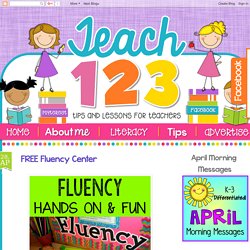
After giving the Dibels, I found that I needed to strengthen my students' fluency skills. My schedule already seemed completely full. Top 10 Tips for Building Fluent Readers + Link Up! We have all heard about the shift that happens, usually between second and third grade, when students (should) go from learning to read to reading to learn.

Unfortunately, for some students, their ability to read to learn is stifled by their inability to read fluently. Even for those kids who can read at an average pace, the faster and more accurately they can read and decode, the more effectively they can comprehend. When I taught third grade, and now as an interventionist, the importance of fluency is empathized more than ever (and has definitely met some critics). I know that fluency is NOT the end-all, be-all, but a lot of research proves that it is important, and a lot of schools are trending toward fluency being a high priority.
I have compiled a list of some of the resources and strategies I have used when teaching in the regular education classroom and as an interventionist. 1. I know what you’re thinking—this is obvious. 2. Fluency by Teach123-Michelle. Fluency: Reading fluency is such an important part of reading. Yet it's hard to find time in a busy schedule to devote to fluency activities. This is a center where two students can work together to improve their fluency skills. I have some fluency task cards that your students might like. Here are the links: Fluency Task Cards - R-controlled vowels.
Comprehension Connection: Five Fluency Freebies for Friday. Today is Friday, and we know what that means. It's Five for Friday day. For my Five for Friday, I thought I'd share five fluency freebies. Fluent reading is reading that is at a steady pace with expression and phrasing. Fluent reading observes punctuation and includes automatic word recognition. These freebies will help you and your students promote fluent reading in your classroom. Fluency. 25 Vocabulary Enrichment Activities for Your Child. Expanding your four-year-old’s vocabulary can be easy and fun through these 25 vocabulary enrichment activities. 1.
Enjoy this activity the next time you read your child a bedtime story! 2. Miss Giraffe's Class: Prefixes and Suffixes Teaching Ideas for First Grade and Kindergarten. Prefixes and suffixes in first grade? Kindergarten? What?! I'm not sure who decided teaching them so early was the way to go but never fear, you're a teacher (a.k.a. superhero who does the impossible on the daily). We've got this. My Heart Belongs in First: Vocabulary. We have a part of our daily schedule called Interactive Read Aloud. During this time I do a variety of activities. One of my favorite activities to do with my students is build their vocabulary. In grad school I read the book, Bringing Words to Life: Robust Vocabulary Instruction. It totally changed my approach to teaching vocabulary. I learned to create meaning activities (with kid-friendly definitions) which get students involved in thinking about words.
For most of these activities students are sitting at the carpet with me. Feel free to click here to download my first vocabulary activity for the book, Fancy Nancy, Bonjour Butterfly. Grow ELL Vocabulary Skills. This article is the first in a two-part series on supporting ELL literacy, sponsored by Middlebury Interactive Languages. If you teach English-language learners, you know what a challenge it can be to keep vocabulary instruction fresh and engaging. That’s why we recently asked educators in our WeAreTeachers Helpline group to share their favorite ways for growing ELL vocabulary in middle school. Here’s what they had to say: Act it out: Shake up your usual vocabulary routine and get students out of their seats by playing a game of vocabulary charades. Write the words that you want to practice on index cards, and invite teams to take turns choosing a card and acting out the word. Want more support for your English-language learners? Doing It Differently: Tips for Teaching Vocabulary.
Every Monday my seventh grade English teacher would have us copy a list of 25 words she'd written on the board. We'd then look up the dictionary definitions and copy those down. For homework, we'd re-write each word seven times. Dabblingmomma: Reading Comprehension Activity. My daughter loves when we have storytime at our house. Every day we can easy read for 15-30 minutes. Visits to our local library is always exciting because of the idea of finding new books to enjoy. There has been one book that is not new to most, Cloudy with a Chance of Meatballs. Reading Resources {FREEBIE} - All Students Can Shine. Hi everyone, Teacher to the Core: Will they ever reach grade level? Life in First Grade: New Literacy Centers. Wednesday I presented at the Northeast Alabama Early Childhood Conference.
I had so much fun and got to meet the fabulous Kim Adsit. Miss Thrifty SLP: Pinterest project. Pinterest is full of wonderful ideas if you are someone who enjoys making therapy materials. I'm not the best at crafty creations, but I was inspired by a photo that one of my coworkers recently posted. It's a Guided reading beach ball by Carson-Dellosa.